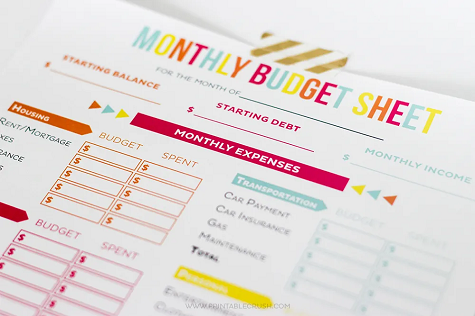A typical budget sheet includes sections for listing sources of income, such as salaries, wages, or any other earnings, as well as categories for various expenses, such as housing, transportation, food, healthcare, debt payments, savings, and personal expenses. Users input estimated amounts for each income source and expense category based on their financial situation.
Throughout the month, individuals can record their actual income and expenses in the budget sheet to compare against the initial estimates. This allows them to see where their money is going and whether they are staying within their budget. By regularly reviewing the budget sheet, individuals can identify areas where they may need to adjust their spending habits to meet their financial goals, such as saving for a large purchase, paying off debt, or building an emergency fund.
Budget sheets can be created using spreadsheet software like Microsoft Excel, Google Sheets, or by using pre-made templates available online. They can be customized to fit specific needs and preferences, making them a flexible and versatile tool for financial management.
A budget sheet broken down:
Income:
- This section lists all the sources of income you have for the month. It could include salaries, wages, freelance earnings, rental income, etc. You fill in the amount you expect to receive from each income source.
Expenses:
This section breaks down your expenses into categories to give you a clear picture of where your money is going.
Housing: Includes expenses related to your accommodation such as rent or mortgage payments, utilities (electricity, water, gas, internet), home insurance, and any expenses for repairs or maintenance.
Transportation: Lists expenses related to getting around, such as car payments, fuel, insurance, and maintenance costs.
Food: Divided into groceries and dining out expenses. Groceries include food items purchased from supermarkets or stores for cooking at home, while dining out covers meals at restaurants or fast-food establishments.
Healthcare: Includes expenses related to healthcare, such as health insurance premiums, medication costs, and doctor visit copayments.
Debt Payments: Lists any payments you need to make towards debt, including credit card payments, loan repayments, or any other outstanding debts.
Savings: This category includes any funds you allocate towards saving for emergencies, retirement, or other financial goals.
Personal: This category covers personal expenses that don't fit into the other categories, such as entertainment, clothing, and miscellaneous expenses.
Total Expenses:
- This section calculates the total amount you expect to spend for the month by summing up all the expenses listed in the previous section.
Net Income:
- This is calculated by subtracting your total expenses from your total income. It shows you the remaining amount of money you'll have after covering all your expenses for the month.
By using a budget sheet like this, you can track your income and expenses, identify areas where you might be overspending, and make adjustments to your spending habits to achieve your financial goals. It's important to review and update your budget regularly to reflect any changes in your income or expenses.

 A budget sheet, also known as a budget template or budget spreadsheet, is a tool used to track income and expenses over a specified period, typically on a monthly basis. It helps individuals or households manage their finances by providing a structured format for organizing and monitoring their money flow.
A budget sheet, also known as a budget template or budget spreadsheet, is a tool used to track income and expenses over a specified period, typically on a monthly basis. It helps individuals or households manage their finances by providing a structured format for organizing and monitoring their money flow.